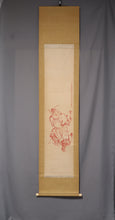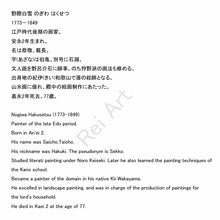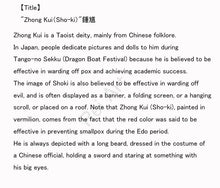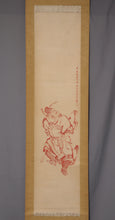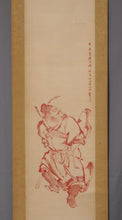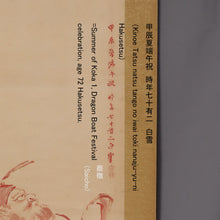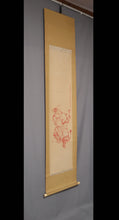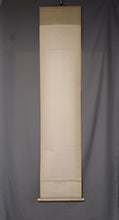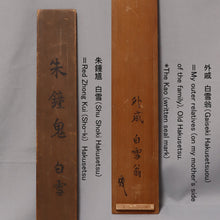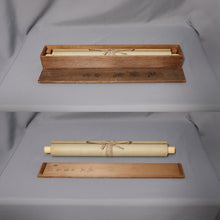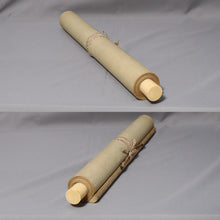
For all customers
※Products that use ivory will be changed to other materials and shipped.
This is because the Washington Convention currently prohibits the export and import of ivory products in all countries including Japan.
※you may be charged Value Added Tax (VAT) by the state when you receive your purchased artwork.
(Amount according to the laws of each country.Nearly 20%-30% of the purchase price and shipping costs)
Art work details
Setting weight
This piece will be shipped at 0.8 kg including packaging.
Material
Japanese pigments on paper
Size
Overall: vertical 193.5 × width 41 cm*width does not include roller ends.
(the work: vertical 128.5 × width 29.9cm)
Condition
・There are burns, stains, wrinkles on the Japanese paper on the back of the cover.
・There are some burns, stains, wrinkles, original tear marks on the image.
・There are warp, burns, stains, wrinkles in mounting.
Remarks
Roller ends is Bone.
・Box inscription by the original owner of the work.
Materials for mounting
・All of them are made of silk.
Other
**There is a note about shipping restrictions and VAT. Please check before purchase.**
*There may be a slight difference in color between the photo and the actual product.
Biography
Nogiwa Hakusetsu (1773-1849)
Painter of the late Edo period.
Born in An'ei 2.
His name was Saicho,Taicho.
His nickname was Hakuki. The pseudonym is Sekko.
Studied literati painting under Noro Keiseki. Later he also learned the painting techniques of the Kano school.
Became a painter of the domain in his native Kii Wakayama.
He excelled in landscape painting, and was in charge of the production of paintings for the lord's household.
He died in Kaei 2 at the age of 77.
A word from the store
The design of the vermilion Zhong Kui (Sho-ki) represents the wish of the people of the time to be rid of smallpox, which was prevalent during the Edo period.
The red color represents smallpox. A cure for this disease, which was prevalent during the Edo period, had not yet been established.
It is thought that people at that time displayed Zhong Kui (Sho-ki) painted in vermilion in their alcoves, hoping that the power of Zhong Kui (Sho-ki) would exterminate the disease and that their children would grow up healthy.
Even today, people around the world are suffering from infectious diseases.
Although times may have changed, our wish that this situation will soon improve is the same.
Main Meaning
"Zhong Kui(Sho-ki)"
Zhong Kui is a Taoist deity, mainly from Chinese folklore. In Japan, people dedicate pictures and dolls to him during Tango-no Sekku (Dragon Boat Festival) because he is believed to be effective in warding off pox and achieving academic success. The image of Shoki is also believed to be effective in warding off evil, and is often displayed as a banner, a folding screen, or a hanging scroll, or placed on a roof. Note that Zhong Kui (Sho-ki), painted in vermilion, comes from the fact that the red color was said to be effective in preventing smallpox during the Edo period. He is always depicted with a long beard, dressed in the costume of a Chinese official, holding a sword and staring at something with his big eyes.
Precautions
[Important Notice]
Please pay attention to the following points before buying.
●We will ship from Japan to the rest of the world.
As a result, you may be charged Value Added Tax (VAT)
by the state when you receive your purchased artwork.
(Amount according to the laws of each country.
Nearly 20%-30% of the purchase price and shipping costs)
●In addition, please note that we are not able to "under-value" the purchase price at the time of shipping.
●※Recently, there has been an increase in the number of cases
where packages have not been delivered to Italy.
For Italian customers, we may ask for "codice fiscale" after
purchase. Please be forewarned.
●Currently, the Washington Convention prohibits the export and import of ivory products in all countries including Japan. If ivory is used as the material in the hanging scroll / Bokuseki work, we will change it to another material and ship it.
Thank you for your understanding in advance.
About shipping
The standard shipping fee is as follows.
Currency unit is Japanese Yen.
If you have any questions, please contact us.
EMS
| EMS | |||||
|---|---|---|---|---|---|
| Maximum weight | Area | ||||
| A | B | C | D | E | |
| Asia | Asia2 | Europe, Oceania, Middle East, North Americ | North America | Africa | |
| 0.5kg | ¥1,450 | ¥1,900 | ¥3,150 | ¥3,900 | ¥3,600 |
| 0.6kg | ¥1,600 | ¥2,150 | ¥3,400 | ¥4,180 | ¥3,900 |
| 0.7kg | ¥1,750 | ¥2,400 | ¥3,650 | ¥4,460 | ¥4,200 |
| 0,8kg | ¥1,900 | ¥2,650 | ¥3,900 | ¥4,740 | ¥4,500 |
| 0.9kg | ¥2,050 | ¥2,900 | ¥4,150 | ¥5,020 | ¥4,800 |
| 1.0kg | ¥2,200 | ¥3,150 | ¥4,400 | ¥5,300 | ¥5,100 |
| 1.25kg | ¥2,500 | ¥3,500 | ¥5,000 | ¥5,990 | ¥5,850 |
| 1.5kg | ¥2,800 | ¥3,850 | ¥5,550 | ¥6,600 | ¥6,600 |
| 1.75kg | ¥3,100 | ¥4,200 | ¥6,150 | ¥7,290 | ¥7,350 |
| 2.0kg | ¥3,400 | ¥4,550 | ¥6,700 | ¥7,900 | ¥8,100 |
| 2.5kg | ¥3,900 | ¥5,150 | ¥7,750 | ¥9,100 | ¥9,600 |
| 3.0kg | ¥4,400 | ¥5,750 | ¥8,800 | ¥10,300 | ¥11,100 |
| 3.5kg | ¥4,900 | ¥6,350 | ¥9,850 | ¥11,500 | ¥12,600 |
| 4.0kg | ¥5,400 | ¥6,950 | ¥10,900 | ¥12,700 | ¥14,100 |
| 4.5kg | ¥5,900 | ¥7,550 | ¥11,950 | ¥13,900 | ¥15,600 |
| 5.0kg | ¥6,400 | ¥8,150 | ¥13,000 | ¥15,100 | ¥17,100 |
Country classification
A: Asia
China, South Korea, Taiwan
B : Asia
Hong Kong, Macau, Singapore, Thailand, Philippines, Vietnam, Malaysia
C : Europe, Oceania, Middle East, North America
Austria, Belgium, Bulgaria, Croatia, Czech Republic, Denmark, Estonia, Finland, France,
Germany, Hungary, Iceland, Ireland, Italy, Latvia, Lithuania, Luxembourg, Netherlands, Norway, Poland,
Portugal, Slovenia, Spain, Sweden, Switzerland, the United Kingdom, Australia, Canada, Mexico, New Zealand,
Romania, Greece
D : North America
United States of America
E : Africa
South Africa










